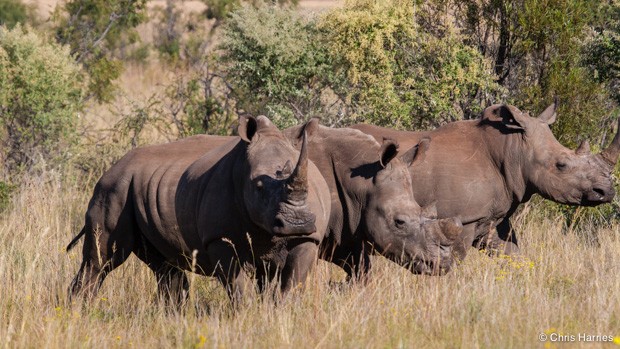It’s a conservation debate that’s as fiery and emotive as they get: how does South Africa, which is home to 90% of Africa’s rhinos, go about protecting them from a poaching pandemic that’s likely to claim over a thousand victims before the year is done (and could eventually devastate rhino populations)? That debate really intensified this week when the South African government gave its strongest indication yet of the route it plans to take: the country’s environment minister announced that South Africa would back “the establishment of a well-regulated international trade” in rhino horn and seek permission for a one-off sale of stockpiles worth around $1-billion.
With the news setting off heated discussion online, we spoke to one expert who believes well-regulated trade is the right answer. Conservation economist Michael ‘t Sas-Rolfes, who has written extensively about the market factors driving the poaching crisis and the ‘economics’ of rhino conservation, answers a few of our questions on this controversial topic.
Q: With a background in business and economics, you haven’t really followed the ‘conventional’ path into the area of wildlife conservation. How do you think those skills help you to see the poaching crisis from a different angle?
A: I think they are not only helpful, but essential. The poaching crisis – and indeed many other conservation problems – is driven by human behaviour. To solve such problems we need to come to grips with the incentives driving that behaviour and the systems that create those incentives. So we need to have an understanding of social sciences more than biological sciences: that includes economics, psychology, sociology and politics! Most importantly, we need to understand how markets work.
Q: For those of us who don’t speak ‘economese’, it can be tricky to understand the poaching problem and the rhino-horn market in rigorous economic terms. Is there a simple way to break things down?
A: Simply put, the way things are set up right now, poachers and illegal traders have much stronger incentives – and more money at their disposal – to kill rhinos than individual rhino owners and custodians have to protect them. This is because Asian demand for rhino horn is real and not expected to decline in the near future, and – most importantly – Asian suppliers are expecting rhino horn to become commercially extinct and therefore increasingly valuable over time. We are facing some very powerful market forces here.
Q: Do you think more people would see legalization of the rhino horn trade as a viable option if they were able to understand the economic forces that drive the horn market?
A: Most definitely!
Q: The widely accepted timeline seems to be that the poaching crisis was sparked around 2007 thanks to rising demand in Vietnam and the emergence of the infamous cancer-curing myth. But you believe the timeline is actually quite different…
A: Yes, I think that is a somewhat misguided interpretation of what actually happened (as seen through a Western lens of understanding). Rhino horn has been a valued commodity in Asia for thousands of years, for both ornamental and medicinal purposes, mostly in elite circles. An essential part of the horn’s current value is its scarcity. As a medicine, it is – and has always been – used to treat a wide range of conditions related to inflammation and toxicity in the body. In some circles it is considered the ultimate medicine to treat serious (and not so serious) cases – i.e. it is the Rolls Royce of traditional Chinese medicine. Evidence suggests that demand is rising in both Vietnam and parts of China along with increased affluence (not just for cancer treatment, but for all sorts of medicinal and ornamental uses, but with the underlying prestige factor). The poaching crisis was sparked when we responded to that increasing demand in exactly the wrong way: by restricting the supply. Basic economics tells us that if you reduce the supply in the face of increasing demand, market prices will rise. If prices rise, so do the potential rewards for poachers and illegal traders.
Q: Many anti-poaching campaigns are aiming to ‘reduce’ Asian demand for rhino horn through awareness and education. Can ‘reeducation’ work?
A: I am skeptical that this approach can deliver results fast enough to bring poaching down to sustainable levels in the short and even medium term. We are dealing with a product market based on very deeply held cultural values and beliefs. Those advocating demand reduction are unable to tell us how quickly this can work and – most importantly – how much it will cost to be effective and who is going to pay for it.
Q: Aside from awareness campaigns, you argue that enhanced security (and what you call after-the-fact enforcement) will not be enough to halt rampant poaching. Why?
A: Poachers and other criminals have very short time horizons. If you offer them a huge reward now with a fairly low probability of being caught and punished at some time in the vague future, they will typically ignore that potential cost. And what is the point of prosecuting them a year or two later anyway? By then a whole bunch of new poachers and criminals are already in the game. To stop poaching you need to convince poachers that they are very unlikely to succeed in their initial poaching attempt – that it simply won’t be worth it in the first place. The only way you can do that is by lowering the value of their potential initial take (dehorning rhinos and/or reducing the price of horn) and – most critically – having such effective security on the ground that the rhinos are almost impossible to get to.
Q: What would you say to those who feel that farming rhinos for their horns would effectively reduce one of Africa’s most iconic wild animals to the status of livestock?
A: I fear we are faced with a stark choice: a lower risk option of white rhino ‘farming’ as a buffer to wild populations of all species – or the continued severe threat to all species and likely reduction (and even extinction) of almost all wild rhino populations.
Q: Even if trade is legalised and farming rhinos becomes a reality, is it possible that some consumers may still seek out horns sourced from “wild” (poached) rhinos rather than their “farmed” counterparts (the same way wild-caught salmon is preferred over the farmed variety)?
A: I consider this less likely with rhinos as we are not talking about artificial and intensive feed-lot farming, but rather ranching – periodically removing the horn from free-ranging rhinos (that is by far the most cost-effective way to produce horn). Conscious meat consumers avoid grain-fed feed-lot beef but are happy to eat grass-fed free range beef, even if the cattle in question are not truly ‘wild’. I would not expect rhinos to be much different. If you offer consumers the choice between genuine certified legal free-range rhino horn and illegal horn of unknown origin that may be a fake, I suspect few consumers would pay a premium for the latter. If anything, most would probably be willing to pay far less.
Q: What about those who argue that South Africa’s government agencies are too corrupt and ineffective to properly monitor and manage legal trade in rhino horn?
A: You could argue the same for controlling the illegal trade. The argument doesn’t make any sense. With legal trade, the owners and custodians would be getting the money – lots of it – that is now all being taken by criminals. With legal trade the owners and custodians would be able to afford better security and have a much stronger incentive to protect and breed up their rhinos.
Q: Even if South Africa decides to move forward on the road to legalisation, legal trade hinges on approval from CITES – which can only be granted at the next CITES conference in 2016. What are the logistics of that approval process and who would be involved?
A: The logistics are intimidating. South Africa will have to secure the buy-in of key consumer countries, which will need to amend their laws to allow for this. The mechanism is also critical – there are many wrong ways to set up legal trade and only one right one. There is still a lot of work to be done on this and everyone needs to be involved, from government agencies to private agents and NGOs.
Q: Can trade be legalised in time to save Africa’s rhinos?
A: I regret that we are likely to lose a lot more rhinos in the next few years, whatever happens. With a properly established legal trade we have a better chance of navigating our way out of this mess and securing the future of most rhinos into the longer term. Without legal trade I fear rhino numbers will be severely reduced. I think extinction is unlikely, but the longer-term prognosis for rhinos will not be as good.
This article originally appeared at Earth Touch. Michael ‘t Sas-Rolfes is a research fellow at PERC.




